Table of Contents
Bald cypress is one of the most recommended bonsai trees for bonsai beginner, and this is because the tree can be grown in various ways. Bonsai beginner with no knowledge about how to Bonsai a tree can decide to either start with smaller trees picked directly from nature or buy a starter tree from attic stores.
Getting started with a Bald cypress is simple and here in this article, I will be discussing in detail, how best you can grow a Bald cypress Bonsai tree to connect your interior with the artistic beauty of nature.
| Scientific Name | Taxodium distichum |
| Average Height | 1524 to 2133.6 cm |
| Average Spread | 609.6 to 1371.6 cm |
| Bloom Time | Non-flowering |
| Family | Cupressaceae |
| Origin Country | Southeastern United States |
| Watering needs | Medium to wet |
| Sun requirement | Full sun |
| Maintenance level | Low |
Bald Cypress Bonsai history
The cypress tree is indigenous to the southern part of the united states. Its origination can also be traced back to Guatemala and Mexico as well. Although in these countries, the Bald cypress didn’t start as a Bonsai tree; its journey to becoming a Bonsai started in 2000.
In the year 2000 late Mr. Vaughn Banting who is a former member of the National Bonsai Foundation Board; a former chairman of the American Bonsai Society, and a former chairman of Bonsai club International, gave the tree to the Bonsai museum as a donation. Mr. Banting was proficient in the field of plant care as well as garden design.
According to Micheal James, a museum curator, the donation made by Mr. Banking started as a nursery stock which was planted from seed, cuttings, and in a container. Later, it was planted on the land so that it can fully grow into a large tree or shrub.
He also made claims that the Cypress tree can mostly be found in the southeast United States around the swampy areas where its roots can be fully drenched in water. He also said that unlike most other Bonsai trees it would be difficult to find the cypress in Japan and China unless it was transported by water or air.
At first, when Banting started to train the tree, he intended to grow the tree to look like the customary Japanese formal-upright style; a natural growing habit common to young Bald cypress. However, he later discovered that is impossible to have an adult Cypress grow in that formation.
After this discovery, the tree was later trained by the museum curators and volunteers in a flat-top formation; which was the initial style the tree was sported when Banting made the donations at first. Banting then studies the unique growing habits displayed by the tree as it matures. According to James, Banting was able to create the flat-top configuration after he studied the unique growth habit the tree displayed as it matures.
Banting stated that the success of the flat-top style was a result of the proper thinning and positioning of the uppermost branches. After training the tree for 50 years and at three different stages of training, Banting’s cypress tree was exhibited for the first time in the North American Pavillon of the museum. The Cypress flat-top formation caught the won the admiration of a lot of onlookers and since then, the museum has been on the lookout for a new innovative way to Bonsai design.
Can you Bonsai Bald cypress?
Yes, you can Bonsai a Bald cypress. If you have little or no knowledge about how to Bonsai a tree, the Bald cypress is one of the best tree options for you to start with because it is very easy to raise as it can be successfully cultivated in various kinds of soil whether it be well-drained or boggy marsh areas where growth would have been difficult if planted the natural way.
Bald cypress Bonsai scientific name
The scientific name of a Bald cypress is Taxodium distichium.
Bald cypress Bonsai care
Although cultivating a Bald cypress might be easy, but it also requires to be raised under conducive conditions to produce desirable results. Explained below are the necessary care requirements for the successful cultivation of a Bald cypress.
Bald cypress temperature
Bald cypress can grow under a wide range of temperatures, which is why it is planted under divergent conditions in different states within the United States alone. Bald cypress is resistant to temperatures of -20° to -29°F. And can be planted in humid, wet sub-humid, and dry sub-humid climates.
Bald cypress fertilizer
Bald cypress requires more water than most other Bonsai trees; in as much as this could be good for the health of the tree, there is also a downside to it. Too much water means the nutrients in the soil will be leached away by water and as a result, there will not be enough nutrients that can be used for growth unless you supplement with fertilizers.
Fortunately, any type of liquid fertilizer can be applied to a Bald cypress Bonsai. Although it must be a sufficiently balanced fertilizer. Your Bald Cypress should be fertilized from the beginning of spring to autumn and must be applied at least once a week or once in two weeks.
Another advantage of the Bald cypress is that your fertilizer does not necessarily have to be synthetic-based. You can make use of any liquid compost tea, or organic-based fertilizers. However, any fertilizer of your choice must be applied according to the dosage instructions on the fertilizer.
Bald cypress Bonsai trimming and pruning
The best time to prune a Bald cypress Bonsai is when its shoots start to develop lateral ramification. If you prune a Bald cypress too early, the shoot will die during fall. But when your prune early during spring, it will grow healthily and give you your intended result.
How to prune a Bald cypress Bonsai
Bald cypress is pruned just like every other Bonsai with secateurs or pruning shears. However, before pruning your Bald cypress, make sure you which cypress style is best for your tree. Here are a few steps involved in pruning a Bald cypress tree.
- Remove excess leaves all through the growing seasons with secateurs or pruning shears.
- Pinch-back new shoots regularly to style your Bonsai into shape.
It is recommended that you train your Bald cypress into a formal or an upright shape.
Bald cypress Bonsai repotting
Repotting is very important to the growth of your Bald Bonsai because it will provide a new better soil to germinate and also it will give you the chance to loosen up compacted roots of the tree. Young Bald Bonsai requires to be repotted more because they are the most likely to be rootbound.
Your Bald cypress should be planted in soil that can hold water and that is why most growers make use of mushroom compost to take care of the requirement. Also, make use of shallow pots and ensure that the outer part of the pot is in good condition. You can secure the outer part by glazing it.
When to report a Bald cypress Bonsai
A Bald cypress needs to be repotted at least once every 2 years. Younger trees should be repotted more frequently based on this repotting schedule. Older Bald cypress on the other hand is best repotted at least once in every 3 to 5 years.
Bald Cypress Bonsai pests & diseases
Fortunate enough, Bald cypress Bonsai is immune to almost every pest and. However, you must watch out for Twig blights. Twig blights are pathogens that affect weakened, injured, or dead leaves. Over-pruned trees are the most vulnerable to this fungus.
If after pruning, you noticed some dying branch tips, prune those dying tips to stop the Twigblight infection from spreading further to other parts of the tree. Although if your pruning is done the right way, your tree will be free from Twig blight infection.
Bald cypress Bonsai soil
A Bald cypress will thrive well in heavy soil like the compact mushroom compost. This is the best option if the tree is not kept in a watery space. The heavy soil will help the tree to retain as much water as possible so that it does not dry out completely.
The best soil for a Bald cypress Bonsai
Bald cypress bonsai can grow in any kind of soil. It doesn’t matter whether it is loamy, acidic, sandy, moist, well-drained, or clay soil. However, the best soil for a Bald cypress is heavy soil.
Bald cypress loves watery areas as it needs enough water to germinate; making use of heavy soil will help prevent the soil from drying out completely because it retains water.
Bald cypress watering
This is a bonsai tree that loves water, therefore, you must water the tree regularly to keep it alive. If you are the busy type, you can fulfill the daily water requirement of your tree by using a pot placed in a shallow saucer then filling it with water.
Your Bald cypress should be watered at least once a day during the growing season. Water it less in the winter and water more in the summer. During winter, the leaves of Bald cypress usually fall, so you can get them once every few months without killing your tree. What is important in watering a Bald cypress is that you must not allow the soil to completely dry out.
Can you overwater a Bald Cypress?
No, Bald cypress loves water, therefore they cannot be overwatered.
Bald cypress sunlight requirement
Bald cypress should be planted under the direct sun when it is at its growing season. They require a moderate level of warmth and light to survive. Bald cypress may find it difficult to grow under low temperatures especially during wintertime.
Bald cypress Bonsai progression
Image 1
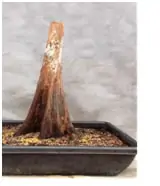
The above image shows a 6 ft trunk of a Bald cypress Bonsai tree.
Image 2
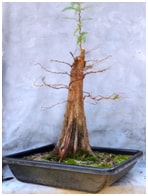
The second image is a picture of the Bald cypress during its first year, ready to be defoliated.
Image 3
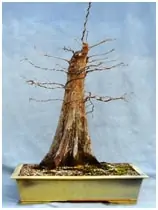
An image of a Bald cypress at the beginning of the 2nd year growing season. A good branch structure is already formed.
Image 4
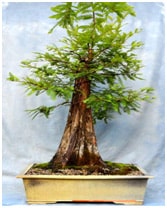
Two months after branch formation new leaves are starting to emerge in full and continue to exhibit rapid growth.
Image 5
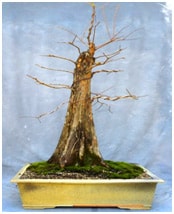
The tree was further defoliated in the 2nd year around early July in preparation for the next growing season. If you want to learn how to defoliate bonsai trees, please refer to our previous guide for more info.
Image 6
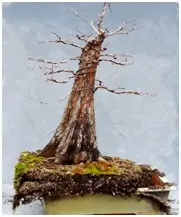
The tree is now ready to be root-pruned after having stayed on the pot for about 4 years.
Image 7
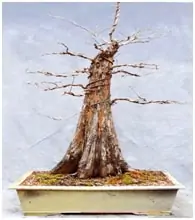
Picture of the Bald cypress after root pruning getting ready for the year’s growing season.
Image 8
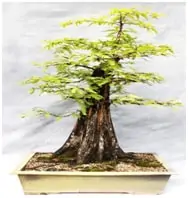
Picture of the tree after the year’s growing season. You will notice that the leaves do not as healthy as it was in the first year’s growing season (image 4). To correct an abnormal growth just like this, all you have to do is apply fertilizer.
Image 9
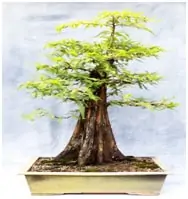
This is what the tree looks like a few weeks after fertilizer application. You can see that it is growing healthier.
Image 10
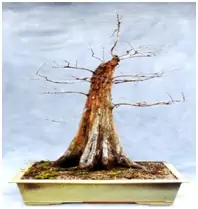
The look of the tree around December at its 4th year. The wires have been removed at the beginning of the season and the trunk is completely cleaned.
Does Bald cypress Bonsai lose its leaves during winter?
Yes, Bald cypress loses their leaves during winter. During winter, Bald cypress shed most of their needlelike leaves due to a general lack of water which is necessary for their growth. The word “Bald” in their nomenclature was given to denote their general tendencies to drop lose their leaves early in the seasons.
How to take care of Bald cypress during winter
Although most Bald cypress loses their leaves during winter, they do not require any extra care or attention. All you have to do is to check regularly whether the snow has caused any damage or not. If you notice that a branch is burdened with snow, gently clear the snow off the branches. Also, during fall, make sure you water your Bonsai regularly especially around October to keep them alive through the season.
Bald cypress Bonsai styles
Another unique quality of a Bald Bonsai is that you can style it to form any shape of your choice. Discussed below are different styles you can shape your Bald Bonsai to form.
Flat top Bald cypress Bonsai
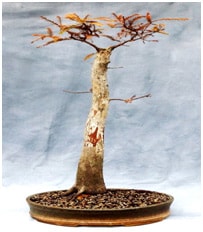
Pictured above is a typical image of what a flat-top Bald cypress should look like. The Bald cypress in this picture has been trained for only a year. (For more details, refer to the history of Bald cypress section in this article)
Peve Minaret Bald cypress Bonsai
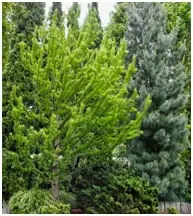
An image of a typical Peve Minaret Bald cypress Bonsai.
A Peve Minaret is an incredible Bald cypress species that exhibit similar growth to a miniaturized tree. At 2ft tall, the branch of a Peve Minaret may look like a full-grown wild specimen. It usually grows a major leader with thick branches on the sides.
This very species responds so well to pruning. Normally growers just cut down lateral branches to 2 inches every year. Doing this will make your tree look cleaner and also boost the number of Minarets.
Bald cypress Bonsai forest
The Bald cypress Bonsai forest is another method of styling a Bald cypress tree and it involves growing a cluster of Bald cypress in a singular pot to mimic a group of Bald cypress growing in the forest. Pictured below is an image of a typical Bald cypress Bonsai forest.
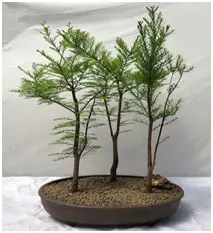
Is Bald cypress Bonsai fast-growing?
Yes, the Bald cypress is a fast-growing tree and can grow up to 36 inches within a year.
Bald cypress Bonsai is an indoor or outdoor tree?
A Bald Bonsai can thrive both indoors and outdoor but, it will thrive better when cultivated outdoors.
How to start a Bald cypress Bonsai
The first thing to do before you start a Bald cypress is to decide how to get the tree. Do you intend to start with seedlings? Or do you prefer to start with a starter tree that is already at the developing stage?
Starting with a cuttings
If you plan to start from scratch, look for the best tree species that will give you that feeling of incredible work of art you desire for. If you live within the united states, around the southern part, you can easily get any of your favorites from the wild because they exist in numbers over there.
If you live in areas where you are finding it difficult to get a good specimen that suits your desire, you can check with local nurseries or garden centers around you for a young tree that will perfectly match your taste.
Have in mind that you are looking for a young tree with a narrow trunk. You can’t get a young tall tree as long as you know how to begin the whole cutting process. It is best to buy or harvest a Bald cypress when it is dormant around late winter or early fall.
Starting with a starter tree
Starting with a starter tree will save you from cutting mistakes, stress, and time. You can either get a starter tree in a group or individually depending on what your choice is.
When you plant in the group, it will be easy to achieve a miniaturized landscape. Plant them in a manner that they will have the semblance of Bald cypress planted in nature: It should look like a circular stand with the appearance of a mound having a tall tree surrounded by smaller trees on the outside.
How to grow a Bald cypress Bonsai from cutting
Discussed below are the necessary steps to take when you decide to plant a Bald cypress from cuttings. Read carefully to grasp full details.
- Get a rooting medium that is slightly moistured with water.
- Get a rooting tray then fill the tray with the rooting medium and put it away.
- Remove every leaves young on the lower part of the cypress cuttings then bury the end of the cuttings inside rooting hormones.
- Plant the cuttings in the rooting medium tray then firm the soil with your hand.
- Ensure that there are enough spaces between the cuttings so they don’t touch each other.
- Moisturize the medium and cuttings with water, then use a plastic bag to cover the tray to maintain the level of humidity and moisture.
- Gently place the tray in a warm place with indirect sunlight.
- Monitor the tray closely so that you can apply water as required to prevent the soil from totally drying out.
- After six weeks, check if there’s any rooting formation by pulling on the cuttings.
- If the roots are forming already, transplant each of the cuttings to a 4-inch growing container.
- Then you can continue to grow the tree indoors for the next 1 year.
What causes Bald cypress Bonsai trees to turn brown?
Your Bald cypress will turn brown if grown under unfavorable conditions. It could be caused by sterile soil deficient in iron content, dry weather, and lastly dehydration which could lead to chlorotic. The first apparent symptoms of a Bald cypress suffering from chlorosis are flaccid, wrinkled, and brownish leaves.
![Pittosporum Bonsai [Pittosporum Tobira]](https://www.bonsai-express.com/wp-content/uploads/2022/05/Pittosporum-Bonsai-365x200.jpg)
![Sorbus Bonsai [Sorbus Aucuparia]](https://www.bonsai-express.com/wp-content/uploads/2022/05/Sorbus-Bonsai-365x200.jpg)
![Tsuga Bonsai [Tsuga Canadensis]](https://www.bonsai-express.com/wp-content/uploads/2022/05/Tsuga-Bonsai-365x200.jpg)
![Tamarix Bonsai [Tamarix Ramosissima]](https://www.bonsai-express.com/wp-content/uploads/2022/05/Tamarix-Bonsai-365x200.jpg)